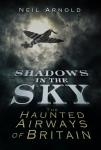
Reviewed by Tom Ruffles
One of my favourite non-Holmes short stories by Sir Arthur Conan Doyle is his 1913 ‘The Horror of the Heights’, which features jellyfish-like creatures living in the upper atmosphere. It is easy to think that the sky comprises a habitat with its own ecology, and Neil Arnold shows that it indeed forms a separate continent; one that, on the evidence he presents, is largely terra incognita. The Big Sky, as Kate Bush put it.
Arnold seems to have been impressed by Conan Doyle’s story too, as he mentions it in connection with actual flying ‘jellyfish’ that have really been reported from time to time. These are merely one kind of the more outré inhabitants of a realm that is chock-full of Fortean weirdness. Naturally UFOs, whatever they may be, loom large, with Arnold’s first British example dating from 1783, but in addition he provides a good sampling of high strangeness in our skies.
There is much on phantom airships, of which many were reported in British skies prior to the First World War. Phenomena such as ball lightning, lights in the sky and mystery hums, vie with falls of frogs, fish, and all sorts of odd stuff (including – yuk – faeces) dropping on bemused witnesses. There are naturally phantom aircraft and airmen, though despite the book’s title you only need an association with the sky to be included, you don’t have to be airborne at the time of the sighting, as witness the famous stories of a deceased Freddy Jackson turning up in a group photograph at RAF Cranwell, and David McConnell appearing to his roommate at Scampton after he had fatally crashed in fog. There are aerial armies and battles, and sundry mothmen, owlmen, bat-winged monkey-birds, winged snakes, horses (!), and beasts for which no name has been coined.
Naturally with such a broad title the sky’s the limit, so Arnold has had to be selective and has, on the whole, done a good job. I would take issue with the statement that while orbs are to be considered artefacts of digital photography, “Ghost hunters disagree and claim that orbs signify the presence of a spirit...” Many ghost hunters (though they may not approve of that term, and call themselves something else) are among the most vocal in dismissing orbs as merely photographic, rather than paranormal, anomalies. Not all ghost investigators are credulous.
Also, there is not much consideration of the role hoaxing plays, for example in sightings of the airships and the Brentford Griffin, and probably a lot else here. However, there have been suggestions that the Griffin, while started as a hoax, effectively took on a life of its own, and Arnold talks about tulpas, phenomena which begin as creatures of the imagination but then attain reality. Maybe so, but you could of course talk equally about contagion, cued misperception and bandwagon-jumping jokers. The maxim “You’ve got to believe it before you can see it”, as the annoyingly fey child tells Ted Danson in Loch Ness, is unreliable science.
This volume is one of a series of Shadows in the ... from The History Press, the others featuring churches, railways, and canals and waterways. Unsurprisingly its breadth means that depth has been sacrificed. Some topics are relatively less well covered elsewhere, butShadows in the Sky will not replace Bruce Barrymore Halpenny’s classic Ghost Stations series (Halpenny receives a single mention, and is referred to as Halfpenny, but he must get that a lot), and it will not satisfy the reader whose primary interest is in UFOs.
Sadly, our troposphere is somewhat duller now than in days of yore, when dragons could be seen disporting themselves over London and the home counties (if only maps nowadays had “Here be dragons” marked on them, and there were instructions for avoiding them on Sat Nav!). Even so, the best advice seems to be: keep watching the skies, but be prepared to take evasive action.
PS Shortly after posting this review, the August 2012 Fortean Times arrived. The cover story is ‘The Sky is Alive’, by Scott Deschaine. His thesis is that the skies are a habitat in the same way that the oceans are, indeed, land, sea and sky are part of a single system. He argues that UFOs and other unexplained aerial phenomena might actually be misidentifications of living creatures, and that the appearance and behaviour of many of them share similarities with those of marine invertebrates.
The issue’s editorial column, entitled ‘Giant jellyfish from outer space!’, is devoted to the article, and as well as discussing the history of such speculation back to Charles Fort (somewhat undermining the cover’s bold headline: “Could UFOs be living creatures? A new theory of aerial phenomena”), talks of the atmosphere as a “Super-Sargasso Sea”. Naturally it refers to Conan Doyle’s story.

